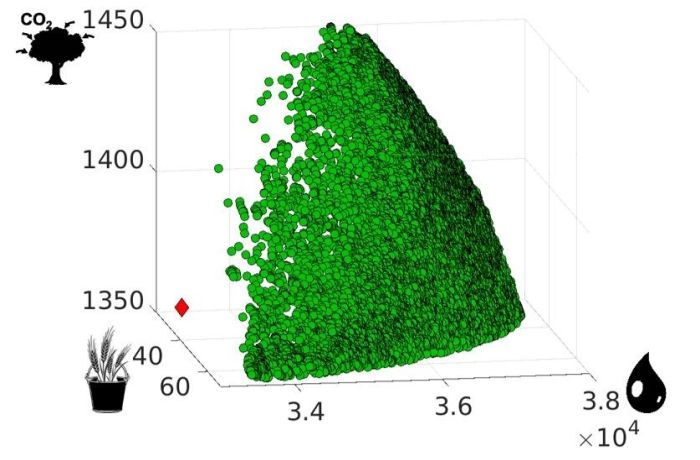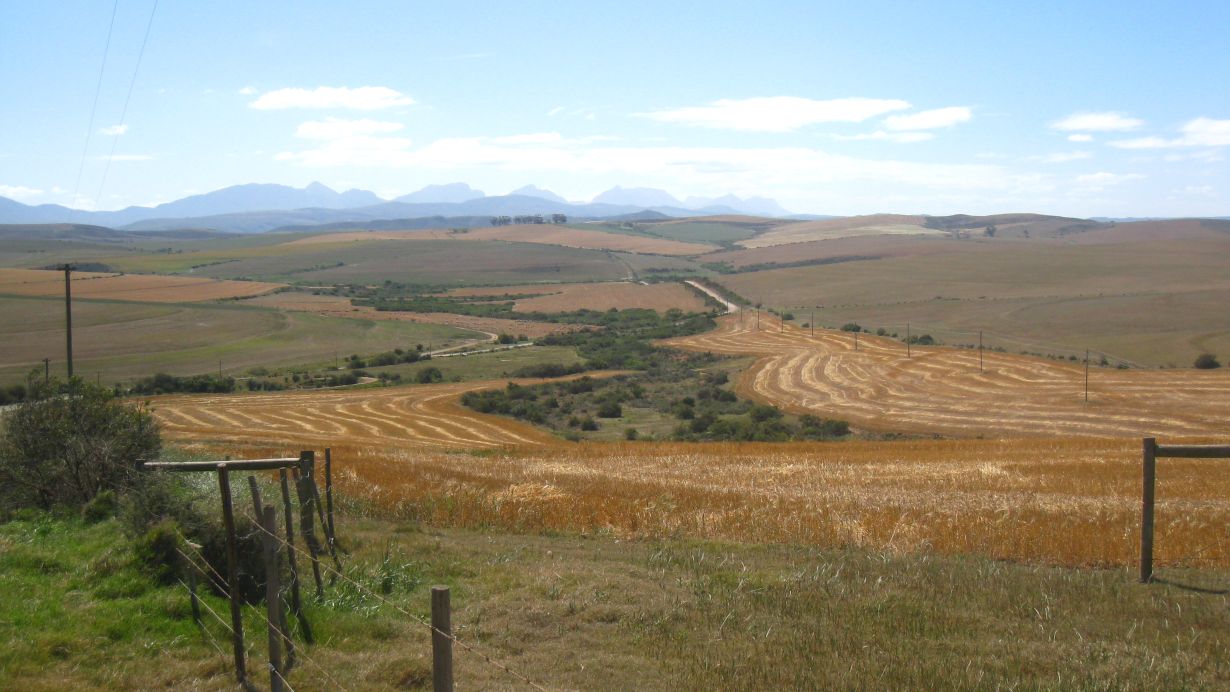Doubling food production, saving water, and increasing carbon storage capacity – this may sound paradoxical, but would be theoretically feasible considering the biophysical potential of the Earth. Reaching this goal, however, would require a radical spatial reorganization of land use. This is the conclusion of researchers from Karlsruhe Institute of Technology (KIT) and the Heidelberg Institute for Geoinformation Technology (HeiGIT) of Heidelberg University. Their findings are published in the Proceedings of the National Academy of Sciences (PNAS) (DOI: doi.org/10.1073/pnas.2220371120).
Use of the Earth’s surface by humans for the production of food, for instance, has changed considerably over the past centuries. Global population is increasing. More food is required and can be transported around the world within shortest periods of time. However, the historically developed food production systems do not reflect the biophysical potential of our ecosystems. The study shows that food is not produced at places where that would be most efficient in terms of area use, water consumption, and CO2 emissions. Instead, deforestation is being continued to obtain cropland and pastures and arid fields are being irrigated. These activities have a massive negative impact on water availability and carbon storage.
But what if fields, pastures, and natural vegetation were moved to where it would be most efficient? What if croplands were restricted to areas that do not require extensive irrigation? To answer these questions, the researchers from KIT and HeiGIT combined a dynamic vegetation model with an optimization algorithm to study alternative global land use scenarios and their impacts.
Optimized Land Use Would Increase Food Production by More than 80 Percent and CO2 Storage Capacity by Three Percent on the Average
The researchers modeled optimized land use for climate conditions of an optimistic scenario and a presently more realistic climate change scenario for the near and far future (2033 to 2042 and 2090 to 2099). The result: Spatial reorganization alone would increase food production by an average of 83 percent, water availability by eight percent, and CO2 storage capacity by three percent. These increases would be even higher, if one of the three parameters would be given priority over the remaining two.
“Our study exclusively covered the biophysical potential as the basis for land use that would consider the target conflicts much better,” says first author Dr. Anita Bayer from KIT’s Campus Alpine in Garmisch-Partenkirchen. “We found that there are indeed regions in which certain land uses would be advantageous or optimal.” According to the study, tropical and boreal forests would have to be preserved or reforested due to their excellent CO2 storage capacities rather than being used as croplands or pastures. Temperate latitudes would have to serve as cropland rather than pastures. This would compensate area loss due to the reforestation of tropical and boreal forests. The wide and open tropical and subtropical savannas and grasslands would have to be used as pastures and for food production. “This optimal land use scheme turned out to be very stable in our study,” Bayer says.
Deliberate Change of Land Use
The study shows that regional practice strongly differs from the theoretically achievable optimum. Massive landuse changes would be required to make better use of the biophysical potential, while increasingincrease food production, water availability, and carbon storage capacity at the same time. “Although such major land use changes appear to be unrealistic, we should be aware of the fact that climate change will be associated with big changes of cultivation areas anyway,” says Professor Sven Lautenbach, researcher of HeiGIT and the Geographical Institute of Heidelberg University. “We should not let these changes happen, but try to manage them taking into account the biophysical potential.”
“Securing global food supply is one of the major challenges of our time and climate change will aggravate this problem in many regions,” says Professor Almut Arneth from the Atmospheric Environmental Research Division of KIT’s Institute of Meteorology and Climate Research, KIT’S Campus Alpine in Garmisch-Partenkirchen. “Our study clearly shows that in spite of unfavorable climatic changes, optimized land use could significantly increase agricultural yields and limit area consumption at the same time. It is now important to find ways to implement land use changes that take into account both biophysical conditions and social aspects.”
Original Publication
Anita Bayer, Sven Lautenbach, Almut Arneth: Benefits and trade-offs of optimizing global land use for food, water, and carbon. Journal Proceedings of the National Academy of Sciences (PNAS), 2023. DOI: doi.org/10.1073/pnas.2220371120
https://www.pnas.org/doi/10.1073/pnas.2220371120

About the Heidelberg Institute for Geoinformation Technology (HeiGIT)
The Heidelberg Institute for Geoinformation Technology (HeiGIT) is funded by Klaus Tschira Foundation and works to improve knowledge and technology transfer from fundamental research in geoinformatics to practical applications based on innovative geoinformation technologies. The Institute studies and develops smart routing and navigation services for sustainable mobility, uses spatial data mining and machine learning processes for the development of innovative services, and supplies geodata for supporting humanitarian aid.
More about the KIT Climate and Environment Center
Heidelberg University was established in 1386. It is a research university with international reach that offers a rich range of subjects in humanities, social sciences, law, natural sciences, engineering, life sciences, and medicine. The university’s leading role in German science is reflected by its successes in the excellence competitions – Heidelberg University is one of the German Universities of Excellence – as well as by its international rankings. Heidelberg University works on the further development of outstanding disciplines, strengthening cross-disciplinary cooperation, and transferring research findings to society. The about 30,000 students are offered research-based studies in more than 180 degree programs with a large variety of subject combinations and individual qualification pathways.
In close partnership with society, KIT develops solutions for urgent challenges – from climate change, energy transition and sustainable use of natural resources to artificial intelligence, sovereignty and an aging population. As The University in the Helmholtz Association, KIT unites scientific excellence from insight to application-driven research under one roof – and is thus in a unique position to drive this transformation. As a University of Excellence, KIT offers its more than 10,000 employees and 22,800 students outstanding opportunities to shape a sustainable and resilient future. KIT – Science for Impact.

